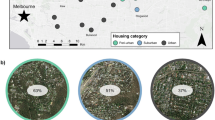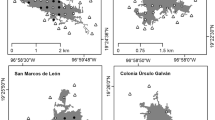Abstract
Variation in densities of native and exotic urban-adapted birds across suburban habitats may reveal levels of adaptation that predict vulnerability to habitat modification over time. We investigated the densities of the eight most common exotic and native birds in a southern hemisphere city across suburbs of varying housing density, vegetative cover and garden vegetation characteristics to determine whether avian population densities are maintained across variations in habitat structure that mirror current temporal trends in land use and landscaping/gardening preferences. We also tested whether densities of birds in residential areas bordering undeveloped patches were higher due to spill-over from patches. Densities of all four native species were highest in undeveloped patches and these species were largely absent from high density housing areas. While densities of two exotic species (blackbird, song thrush) were slightly higher in suburbs with greater vegetation complexity, they were still present in higher density housing suburbs in significant numbers. Common starlings were similarly abundant across all residential habitats and house sparrow density increased in higher density housing areas. Blackbirds appeared least vulnerable to housing densification and landscaping and gardening trends because they were abundant across all habitats, including undeveloped patches. Densities of native birds were higher in residential areas bordering undeveloped patches indicating spill-over was occurring and emphasising the role that patches could play in boosting city-wide native bird abundances. Native birds are vulnerable to reductions in garden size and vegetation complexity that should have little or positive effects on populations of common exotic species.
Similar content being viewed by others
References
Bathgate M (2006) Dunedin City Residential Capacity Study. District Plan Monitoring Series Research Report 2006/1. www.cityofdunedin.com/res_capacity
Blair RB (1996) Land use and avian species diversity along an urban gradient. Ecol Appl 6(2):506–519
Blair RB (2001) Creating a homogeneous avifauna. In: Marzluff JM, Bowman R, Donnelly R (eds) Avian ecology and conservation in an urbanizing world. Kluwer Academic Publishers, Boston, pp 459–486
Buckland ST, Anderson DR, Burnham P, Laake J, Borchers DL, Thomas L (2001) Introduction to distance sampling. Oxford University Press, Oxford
Catterall CP, Cousin JA, Piper S, Johnson G (2010) Long-term dynamics of bird diversity in forest and suburb: decay, turnover or homogenization? Diversity Distrib 16:559–570
Caula SA, Sirami C, Marty P, Martin J-L (2010) Value of an urban habitat for the native Mediterranean avifauna. Urban Ecosyst 13:73–89
Chace JF, Walsh JJ (2006) Urban effects on native avifauna: a review. Landsc Urban Plan 74:46–69
Clergeau P, Croci S, Jokimäki J, Kaisanlahti-Jokimäki M-L, Dinetti M (2006) Avifauna homogenisation by urbanisation: analysis at different European latitudes. Biol Conserv 127:336–344
Coleman GJ (2010) Birds as indicators of sustainable management practices on New Zealand kiwifruit orchards. MSc dissertation, University of Otago, Dunedin
Committee LAE (2005) Crazy paving: the environmental importance of London’s front gardens. Greater London Authority, London
Conole LE (2011) Diverse response of exotic birds to urbanization. Natureza & Conservação 9(1):1–6
Conole LE, Kirkpatrick JB (2011) Functional and spatial differentiation or urban bird assemblages at the landscape scale. Landsc Urban Plan 100:11–23
Croci S, Butet A, Clergeau P (2008) Does urbanization filter birds on the basis of their biological traits? Condor 110(2):223–240
Crooks KR, Suarez AV, Bolger DT (2004) Avian assemblages along a gradient of urbanization in a highly fragmented landscape. Biol Conserv 115:451–462
Daniels GD, Kirkpatrick JB (2006) Does variation on garden characteristics influence the conservation of birds in suburbia? Biol Conserv 133:326–335
Donnelly R, Marzluff JM (2004) Importance of reserve size and landscape context to urban bird conservation. Conserv Biol 18(3):733–745
Evans KL, Chamberlain DE, Hatchwell BJ, Gregory RD, Gaston KJ (2011) What makes an urban bird? Glob Chang Biol 17:32–44
Fernandez-Juricic E (2000) Bird community composition patterns in urban parks of Madrid: the role of age, size and isolation. Ecol Res 15:373–383
Freeman AND (1999) Bird counts in Kennedy’s bush scenic reserve, port hills, Christchurch. Notornis 46:388–404
Freeman C, Buck O (2003) Development of an ecological mapping methodology for urban areas in New Zealand. Landsc Urban Plan 63:161–173
Fuller RA, Tratalos J, Gaston KJ (2009) How many birds are there in a city of half a million people? Diversity Distrib 15:328–337
Garaffa PI, Filloy J, Bellocq MI (2009) Bird community responses along urban–rural gradients: does the size of the urbanized area matter? Landsc Urban Plan 90:33–41
Germaine SS, Rosenstock SS, Schweinsburg RE, Richardson WS (1998) Relationships among breeding birds, habitat and residential development in greater Tuscon, Arizona. Ecol Appl 8(3):68–691
Green DM, Baker MG (2003) Urbanization impacts on habitat and bird communities in a Sonoran desert ecosystem. Landsc Urban Plan 63:225–239
Hall T (2008) Where have all the gardens gone? Australian Planner 45(1):30–37
Hall T (2010) Life and Death of the Australian Backyard. CSIRO Publishing, Collingwood, Victoria
Hedblom M, Söderström B (2010) Landscape effects on birds in urban woodlands: an analysis of 34 Swedish cities. J Biogeogr 37:1302–1316
Hodgson P, French K, Major RE (2007) Avian movement across abrupt ecological edges: differential responses to housing density in an urban matrix. Landsc Urban Plan 79:266–271
Ikin K, Knight E, Lindenmayer DB, Fischer J, Manning AD (2012) The influence of native versus exotic streetscape vegetation on the spatial distribution of birds in suburbs and reserves. Diversity Distrib. doi:10.1111/j.1472–4642.2012.00937x
Jokimäki J, Suhonen J, Inki K, Jokinen S (1996) Biogeographical comparison of winter bird assemblages in urban environments in Finland. J Biogeogr 23:379–386
Jones DN, Wieneke J (2000) The suburban bird community of Townsville revisited: changes over 16 years. Corella 24:53–60
Lim HC, Sodhi NS (2004) Responses of avian guilds to urbanization in a tropical city. Landsc Urban Plan 66:199–215
Loram A, Tratalos J, Warren PH, Gaston KJ (2007) Urban domestic gardens (X): the extent and structure of the resource in five major cities. Landscape Ecol 22:601–615
Loss SR, Ruiz MO, Brawn JD (2009) Relationships between avian diversity, neighbourhood age, income, and environmental characteristics of an urban landscape. Biol Conserv 142:2578–2585
Luck GW, Smallbone LT, Sheffield KJ (2012) Environmental and socio-economic factors related to urban bird communities. Austral Ecol. doi:10.1111/j.1442–9993.2012.02383x
Ludvig É, Vanicsek I, Török J, Csörgö T (1995) The effect of nest-height on the seasonal pattern of breeding success in blackbirds Turdus merula. Ardea 83:411–418
MacGregor-Fors I, Schondube JE (2011) Gray vs. Green urbanization: relative importance of urban features for urban bird communities. Basic Appl Ecol 12:372–381
MacLeod CJ, Newson SE, Blackwell G, Duncan RP (2009) Enhanced niche opportunities: can they explain the success of New Zealand’s introduced bird species? Diversity Distrib 15(1):41–49
Mason CF (2006) Avian species richness and numbers in the built environment: can new housing developments be good for birds? Biodivers Conserv 15:2365–2378
Mathieu R, Freeman C, Aryal J (2007) Mapping private gardens in urban areas using object oriented techniques and very high resolution satellite imagery. Landsc Urban Plan 81:179–192
McKinney ML (2002) Urbanization, biodiversity and conservation. Bioscience 52(10):883–890
McKinney ML (2006) Urbanization as a major cause of biotic homogenization. Biol Conserv 127:247–260
McKinney ML, Lockwood JL (2005) Biotic homogenization: a few winners replacing many losers in the next mass extinction. Trends Ecol Evol 14(11):450–453
Melles SJ (2005) Urban bird diversity as an indicator of human social diversity and economic inequality in Vancouver, British Columbia. Urban Habitat 3:25–48
Meurk CD, Zvyagna N, Gardner RO, Forrester G, Wilcox M, Hall G, North H, Belliss S, Whaley K, Sykes B, Cooper J, O’Halloran K (2009) Environmental, social and spatial determinants of urban arboreal character in Auckland, New Zealand. In: McDonnell MJ, Hahs AK, Breuste JH (eds) Ecology of towns and cities: a comparative approach. Cambridge University Press, Cambridge, pp 287–307
Moller AP, Diaz M, Flenste-Jensen E, Grim T, Ibáñez-Álamo JD, Jokimäki J, Mänd R, Markó G, Tryjanowski P (2012) High urban population density of birds reflects their timing of urbanization. Oecologia 170:867–875
Parsons H, French K, Major RE (2003) The influence of remnant bushland on the composition of suburban bird assemblages in Australia. Landsc Urban Plan 66:43–56
Pauleit S, Ennos R, Golding Y (2005) Modelling the environmental impacts of urban land use and land cover change-a study in Mersyside, UK. Landsc Urban Plan 71:295–310
Perry T, Nawaz R (2008) An investigation into the extent and impacts of hard surfacing of domestic gardens in an area of Leeds, United Kingdom. Landsc Urban Plan 86:1–13
Savard J-P, Clergeau P, Mennechez G (2000) Biodiversity concepts and urban ecosystems. Landsc Urban Plan 48:131–142
Shaw LM, Chamberlain D, Evans M (2008) The house sparrow Passer domesticus in urban areas: reviewing a possible link between post-decline distribution and human socioeconomic status. J Ornithol 149:293–299
Shea K, Chesson P (2002) Community ecology theory as a framework for biological invasions. Trends Ecol Evol 17(4):170–176
Shochat E, Lerman SB, Anderies JM, Warren PS, Faeth SH, Nilon CH (2010) Invasion, competition, and biodiversity loss in urban ecosystems. Bioscience 60(3):199–208
Smith RM, Gaston KJ, Warren PH, Thompson K (2005) Urban domestic gardens (V): relationships between landcover composition, housing and landscape. Landsc Ecol 20:235–253
Sol D, Bartomeus I, Griffin AS (2012) The paradox of invasion in birds: competitive superiority or ecological opportunism? Oecologia 169:553–564. doi:10.1007/s00442–011–2203-x
Thomas L, Laake JL, Strindberg S, Marques FFC, Buckland ST, Borchers D, Anderson DR, Burnham K, Hedley SL, Pollard JH, Bishop JRB, Marques TA (2006) Distance 5.0. Release ‘2’1. St Andrews, Scotland, Research Unit for Wildlife Population Assessment, University of St. Andrews, UK. http://www.ruwpa.st-and.ac.uk/distance/
Thomas L, Buckland ST, Rexstad EA, Laake JL, Strindberg S, Hedley SL, Bishop JRB, Marques TA, Burnham KP (2009) Distance software: design and analysis of distance sampling surveys for estimating population size. J Appl Ecol 4:5–14
Tratalos J, Fuller RA, Evans KL, Davies RG, Newson SE, Greenwood JJD, Gaston KJ (2007) Bird densities are associated with household densities. Global Change Biol 13:1685–1695
van Heezik Y, Seddon P (2012) Accounting for detectability when estimating avian abundance in an urban area. NZ J Ecol
van Heezik Y, Smyth A, Mathieu R (2008a) Diversity of native and exotic birds across an urban gradient in a New Zealand city. Landsc Urban Plan 87:223–232
van Heezik YM, Ludwig K, Whitwell S, McLean IG (2008b) Nest survival of birds in an urban environment in New Zealand. NZ J Ecol 32:155–165
van Heezik YM, Dickinson KJM, Freeman C (2012) Closing the gap: communicating to change gardening practices in support of native biodiversity in urban private gardens. Ecol Soc 17 (1):34. http://dx.doi.org/10.5751/ES–04712–170134
van Heezik Y, Freeman C, Porter S, Dickinson KJM (2013) Garden size, householder knowledge and socio-economic status influence plant and bird diversity at the scale of individual gardens. Ecosystems. doi:10.1007/s10021–013–9694–8
van Rensberg BJ, Peacock DS, Robertson MP (2009) Biotic homogenization and alien bird species along an urban gradient in South Africa. Landsc Urban Plan 92:233–241
Verbeek K, Van Orshoven J, Hermy M (2011) Measuring extent, location and change of imperviousness in urban domestic gardens in collective housing projects. Landsc Urban Plan 100:57–66
Waite E, Closs GP, van Heezik Y, Dickinson KJM (2012) Resource availability and foraging of silvereyes (Zosterops lateralis) in urban trees. Emu http://dx.doi.org/10.1071/MU11093
White JG, Antos MJ, Fitzsimons JA, Palmer GC (2005) Non-uniform bird assemblages in urban environments: the influence of streetscape vegetation. Landsc Urban Plan 71:123–135
Wilson PR, Taylor R, Thomas BW (1988) Effect of topography on seasonal distribution of forest birds in the Ohikanui, lower Buller and Inangahua valleys, North Westland. Notornis 35:217–243
Author information
Authors and Affiliations
Corresponding author
Rights and permissions
About this article
Cite this article
van Heezik, Y., Adams, A.L. Vulnerability of native and exotic urban birds to housing densification and changing gardening and landscaping trends. Urban Ecosyst 19, 1551–1563 (2016). https://doi.org/10.1007/s11252-014-0379-7
Published:
Issue Date:
DOI: https://doi.org/10.1007/s11252-014-0379-7




